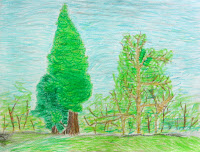Class 5a - PICASSO
IF we did it ... YOU CAN DO IT TOO
 Pablo Picasso, perhaps the most important artists of the twentieth century is the subject on which we worked in the laboratory.
Pablo Picasso, perhaps the most important artists of the twentieth century is the subject on which we worked in the laboratory. First, we documented the life and work of the painter, using the audio-visual show in order to better illustrate the works that Picasso's approach to art, his technique, his style, those who favored, the results obtained.
The workshop itself was to design a Cubist portrait. Taking
the technique of taking measurements using a pencil as
 viewfinder, contested with outstretched arm and pointing to it the ratio of width to height, then reported on the paper, already learned last year, divided in pairs, everyone has done a portrait of his companion, in turn.
viewfinder, contested with outstretched arm and pointing to it the ratio of width to height, then reported on the paper, already learned last year, divided in pairs, everyone has done a portrait of his companion, in turn. Before the "opposite". The
take measures not only need to have control over the work that is taking place, but it also allows you to make a faithful portrait, or at least as faithful as possible to the model.
Above this picture, without changing the sheet, with the same detection technique measures, we made the portrait "profile" the same partner,

Upon completion we had two overlapping portraits, with more eyes, noses, mouths, perhaps touching or overlapping.
The next step was to choose which of these tender parts, such as lines to save, what particular highlight and what to delete.
What we wanted to save was highlighted with a black pencil or a pen up, not to be confused with those lines that are not needed. In the coloring
we gave vent to our imagination and your taste, bearing in mind the theory contrast between colors learned last year and are looking for, however, to create within the painting harmony of colors and shapes.
 The technique to be used for color and that color wax or oil, used but in a realistic but not according to personal taste and, running behind the fantasy.
The technique to be used for color and that color wax or oil, used but in a realistic but not according to personal taste and, running behind the fantasy. The results are portraits of "Cubism", but retain some similarities with the patterns of departure that the children were able to capture in their particularity and their characteristics that distinguish them from others.





















